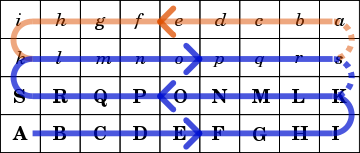- Tâb
-
Tâb is the Egyptian name of a running-fight board game played in several Arab countries, or a family of similar board games played in Northern Africa and South-western Asia, from Persia to West Africa and from Turkey to Somalia, where a variant called deleb is played.
The tâb game is played by two players on a board, often delineated at the ground. The board is 4 squares wide, and usually an odd number of squares long, usually from 7 to 15, but formerly up to 29 squares. Numbering the four rows 1, 2, 3 and 4, from the start one player has one white piece in each field of row 1, and the other a black piece in each field of row 4. The pieces may be stones or made from burnt clay. In Egypt, the pieces are referred to as kelb, meaning dog.
As in the Egyptian game senet and the Korean game Yut, four sticks of a roughly semi-circular cross-section are used as dice. The flat sides are white, and the rounded sides are black. The value of a throw depends on the number of white sides showing, as indicated in the following table.
Whites 0 1 2 3 4 Move 6 1 2 3 4 Extra throw Yes Yes No No Yes Name Tâb Approx. prop. 6% 25% 38% 25% 6% The approximate probabilities shown are based on the assumption that the black and white sides have equal probabilities, which typically is correct to within a few percent.
Throwing a tâb or four sticks showing the same side gives the right to an extra throw.
For each piece, the first move must be a tâb, converting the piece from a Christian to a Muslim and moving it one field ahead. Not till all the player's pieces have been converted is the player allowed to use tâbs for other purposes, but then the player is also allowed to save tâb throws for later use.
The pieces move as shown in the diagram, here shown for "White" starting in its home row A-I. The other player ("Black" starting in home row a-i) moves in the same way, meaning that black and white pieces move in the same direction through each of the rows. When a white piece gets to square s, White can choose to send the piece to a or back to K. However, a given piece can only go into its opponent's home row (for White, a-i) once; the next time it must go back to K, thereafter merely circulating through the 2 middle rows. Once in its opponent's home row, a piece cannot move any further as long as there are any pieces left in its own home row. No piece ever returns to its own home row.
A piece moving to a square occupied by one or more enemy pieces will knock those pieces off the board.
A piece moving to a square occupied by one or more friendly pieces is placed on top of those, and they move as one piece thereafter. If such a stack moves to a square where one of the pieces has been before, the stack is reduced to just one piece, the other pieces being removed from the board. However, the player is not required to utilize a throw leading to such move. A tâb throw can be used to break up a stack so that the pieces move individually again.
The game continues till one player has lost all pieces, whereby the other player wins.
As is clear from the rules, a game position is not given by the position of all pieces only, but also by their pre-history, substantially complicating the game, for better or for worse.
See also
References
- P. Waage Jensen, Brik- og brætspil. ISBN 87-567-2755-0 (in Danish)
- Lane, Edward William (1908), The Manners and Customs of the Modern Egyptians, London: JM Dent & Sons, http://books.google.com/books?id=Ov8HAAAAIAAJ
- Depaulis, Thierry (2001), "Jeux de parcours du monde arabo-musulman (Afrique du Nord et Proche-Orient)", Board Games Studies (Leiden: CNWS Publications) 4: 53–76 (English summary p 149), ISBN 90-5789-075-5, ISSN 1566-1962, http://www.boardgamestudies.info/pdf/aux/BGS4Depaulis1.pdf
- Thierry Depaulis, An Arab game in the North Pole?, Board Games Studies, 4 (2001), pp. 77-82
Categories:- Traditional board games
- African games
Wikimedia Foundation. 2010.

